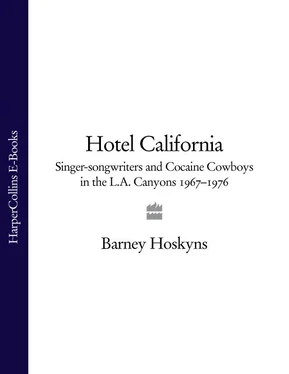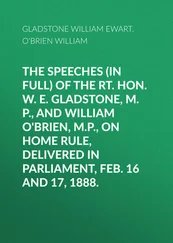‘We used to crank out songs for singers like Dean Martin,’ says David Gates, who packed his wife and kids into a battered Cadillac in 1962 and drove from Oklahoma to California. ‘Seeing some nice songs go down the drain, you started to think, maybe I ought to do them myself.’
‘Dylan exploded the universe of folk songwriting,’ says Jackson Browne. ‘Suddenly there was a whole wealth of ideas out there, and you could discuss anything in a song. You also had Jackie DeShannon on pop TV shows talking about songs she’d written herself. Normally you wouldn’t even wonder where the songs had come from, so it was really something to learn that Jackie had written them.’
When an opening at Warner Brothers came in April 1966, Waronker jumped on it, exploiting the fact that Joe Smith had done business with his father. ‘There was a real sense that there was a change,’ he says of the mood at Warner/Reprise. ‘Mo convinced Frank to let go. He had an amazing sensibility – very sharp, very intuitive.’ Ostin and Smith became a formidable duo: Mo the reclusive mastermind, Joe the more gregarious public face of the company. Lenny, shy like Mo, fitted in perfectly behind the scenes.
There were others, too. Ostin’s greatest gift was delegating taste, cultivating an inner circle of trusted talent-spotters. More often than not these men were mavericks. Bernard Alfred ‘Jack’ Nitzsche, who’d come from Michigan on a bus in 1955 and had arranged the early ’60s hits of Phil Spector, was a difficult and belligerent man but a typical Ostin confidant. He even gave Reprise one of its earliest hits, the 1963 instrumental ‘The Lonely Surfer’. ‘Jack was helpful and supportive,’ says Waronker. ‘He really understood what we were trying to do at Warner/Reprise.’ Others had a different slant on the bespectacled oddball. ‘Jack was very interesting and very talented,’ says Judy Henske, whom Nitzsche produced for Reprise. ‘But he was really crazy if he ever took a drink. I mean, he completely changed. And you didn’t want to be anywhere near that person.’
Another man who had Mo’s ear was Derek Taylor, a suave Liverpudlian who’d moved to LA after working as the Beatles’ press officer back home in England. Dapper and witty, Taylor was a conduit to British talent, but he was also doing press for the Byrds and the Beach Boys. ‘I had two and a half per cent of the Byrds and no fee,’ Taylor remembered. ‘That became quite a lot of money. I didn’t really have to do a lot for them except express what I wanted to. Billy James had really done all the work, but he was such a generous soul he just said, “Over to you.”’
By the spring of 1966, Warner/Reprise was poised to strike – to become a true power on the West Coast. ‘New York itself was going through enormous financial problems and became very hostile to the music business,’ says Joe Smith. ‘So a lot of it shifted out here. California was now regarded by people as the place to go.’ Among the freewheeling folkies who pitched up in Los Angeles in the late summer of 1965 was Stephen Stills. A tenacious Texan with thinning blond hair, Stills had spent time in a military academy and brought the discipline of the place to bear on his musical career. He quickly found the Troubadour more receptive to his talent than Greenwich Village. Hooking up with folk scenester Dickie Davis, he began networking, befriending several key people. Among them was Van Dyke Parks, a diminutive genius who looked like a child and spoke in a camp Mississippi drawl.
Parks and Stills knocked about together, sharing a love of Latin and Caribbean music. Parks was fascinated by calypso; Stills had spent part of his adolescence in Costa Rica. But it was Barry Friedman, former carny and fire-eater, who started making waves for Stephen. A native Angeleno, Friedman had done publicity for the Troubadour. When the Beatles played the Hollywood Bowl in August 1964, he was the publicist for the show. ‘Stephen ended up at my place,’ Friedman says. ‘I guess the floor was softer or something. He was pretty focused. He said he wanted to put a band together, and I thought that would be fun to do. So we just started finding people and phoning around.’
Van Dyke Parks himself passed on the opportunity, as did a young Warren Zevon, then eking out a living as one half of folk duo Lyme & Cybelle. Stills’s abrasive personality may have had something to do with their reluctance. ‘Stephen was not really a very nice guy,’ says Nurit Wilde, a photographer and Sunset Strip scenester of the time. ‘He was definitely talented, but he was not a nice guy then and he continued being a jerk as long as I knew him.’ Drawing blanks in LA, Stills summoned Richie Furay from New York, lying to him that he had a recording deal in place. Furay, a friendlier soul who conformed closer to the archetype of the optimistic folk singer, arrived in California in late 1965.
Parks remained pally with Stills but made his basic living from sessions and arrangements. His work with Brian Wilson on the Beach Boys’ Dumb Angel/Smile – the unfinished psychedelic masterpiece that should have been America’s Sgt. Pepper – had everybody in LA talking. Elbowed out of the Beach Boys picture in April 1967 by the play-it-safe Mike Love, Parks was devastated. Then a call from Lenny Waronker at Warners got his attention. Parks knew Lenny was a rich kid like Terry Melcher, son of actress Doris Day, but it was obvious he was as determined as Mo Ostin and Joe Smith to make Warner/Reprise a home of credible and innovative artists.
Not long after Waronker joined the company, Joe Smith took him up to San Francisco to evaluate the catalogue of Autumn Records, a label Warners was proposing to buy. Co-founded by larger-than-life DJ Tom Donahue, Autumn had a roster of promising groups that Smith fancied: the Beau Brummels, the Tikis, the Mojo Men and more. For Waronker this was an instant opportunity to experiment with ready-made pop acts. Along with Parks he brought in Randy Newman and Leon Russell, an Oklahoman writer and arranger who’d worked on hits by Gary Lewis and the Playboys. The records that they wrote and produced at Warners – particularly those by the newly formed Harper’s Bizarre – were interesting and significant. They pointed backwards to the Brill Building and early Beach Boys pop era, but were also in sync with the complex orchestral psychedelia of Smile . ‘We wanted hits,’ Waronker told writer Gene Sculatti, ‘but we wanted them on our own terms.’
Hit versions of Stills’s ‘Sit Down, I Think I Love You’ (by the Mojo Men) and Paul Simon’s ‘59th Bridge Street Song’ (by Harper’s Bizarre) helped to build a creative nucleus around Waronker. Following Mo Ostin’s lead in making A&R the primary focus at Warners, Lenny gradually introduced – and blended together – the company’s backroom talent: Newman, Parks, Russell, Templeman, Ron Elliott, and guitarists Ry Cooder and Russ Titelman. ‘We never made profit the thrust,’ says Joe Smith. ‘It sounds very self-serving, but that was the reputation we wanted. Van Dyke we were in awe of. This little drug-ridden crazy kid from the South was so talented.’
Yet Waronker could also sense that the days of pop groups like Harper’s Bizarre, in their matching suits and ties, were all but done. The new template for bands was the Rolling Stones, who looked and sounded more threatening than the Beatles ever did. Here was the ultimate gang of rebels, openly flaunting their sexuality and drug use. Meanwhile Mo Ostin, who’d already signed the Kinks for North America, was checking out another UK export, a flamboyant guitarist born and bred in the US. Jimi Hendrix wasn’t Waronker’s personal style, but he rightly identified him as the avatar of a new sensibility in pop – or ‘rock’, as it was starting to be known.
Читать дальше












